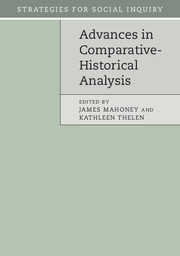Book contents
- Frontmatter
- Contents
- List of figures
- List of tables
- List of contributors
- Preface
- Part I Introduction
- Part II Agenda-setting work
- 2 The developmental state is dead: long live the developmental state!
- 3 Coalitions, policies, and distribution: Esping-Andersen's Three Worlds of Welfare Capitalism
- 4 Not just what, but when (and how): comparative-historical approaches to authoritarian durability
- Part III Tools for temporal analysis
- Part IV Issues of method
- Epilogue: comparative-historical analysis: past, present, future
- Index
- References
2 - The developmental state is dead: long live the developmental state!
from Part II - Agenda-setting work
Published online by Cambridge University Press: 05 July 2015
- Frontmatter
- Contents
- List of figures
- List of tables
- List of contributors
- Preface
- Part I Introduction
- Part II Agenda-setting work
- 2 The developmental state is dead: long live the developmental state!
- 3 Coalitions, policies, and distribution: Esping-Andersen's Three Worlds of Welfare Capitalism
- 4 Not just what, but when (and how): comparative-historical approaches to authoritarian durability
- Part III Tools for temporal analysis
- Part IV Issues of method
- Epilogue: comparative-historical analysis: past, present, future
- Index
- References
Summary
Chalmers Johnson's (1982) MITI and the Japanese Miracle rests on a big empirical puzzle – Japan's extraordinarily rapid growth – and two core claims that have driven the surprisingly resilient research program on the developmental state ever since. The first is that Japan's high postwar growth could be traced to industrial policies that differed from both the “plan ideological” systems of state socialism and the “regulatory state” of Anglo-Saxon capitalism. This branch of the research program attracted by far the most attention because it directly challenged liberal orthodoxy in the economics profession and development policy community. Led by outsiders to that community – Johnson, Alice Amsden (1989), Robert Wade (Wade 1990, 2004; White and Wade 1984), and Ha-Joon Chang (1994) – this line of thinking was subsequently brought into the economic mainstream by economists such as Dani Rodrik (1995) and Joseph Stiglitz (2001), who reiterated the microeconomic logic of state intervention.
The second strand of the developmental state approach probed the political foundations of rapid growth. Industrial policy in the developing world was ubiquitous, but not ubiquitously successful. What accounted for successful industrial policies and the institutions capable of conducting them in the first place? The developmental state literature is typically identified with an institutionalist approach to politics, focusing on the autonomy or insulation of the government from rent-seeking private interests, delegation to lead agencies, and coherent bureaucracies. But Johnson was acutely aware of the centrality of business-government relations to the Japanese model, and subsequent contributions by Peter Evans (1989, 1995) refocused debate on the social foundations of rapid growth.
This second face of the developmental state research agenda developed a particularly strong comparative-historical component. The literature gradually moved beyond Japan and the paradigmatic Northeast Asian cases of Korea and Taiwan to the rapidly growing countries of Southeast Asia and to comparator cases that were distinctly “non-developmental.” This comparative historical research agenda sought to identify the historical sources of development and underdevelopment through close consideration of a small number of cases.
- Type
- Chapter
- Information
- Advances in Comparative-Historical Analysis , pp. 39 - 66Publisher: Cambridge University PressPrint publication year: 2015
References
- 39
- Cited by

